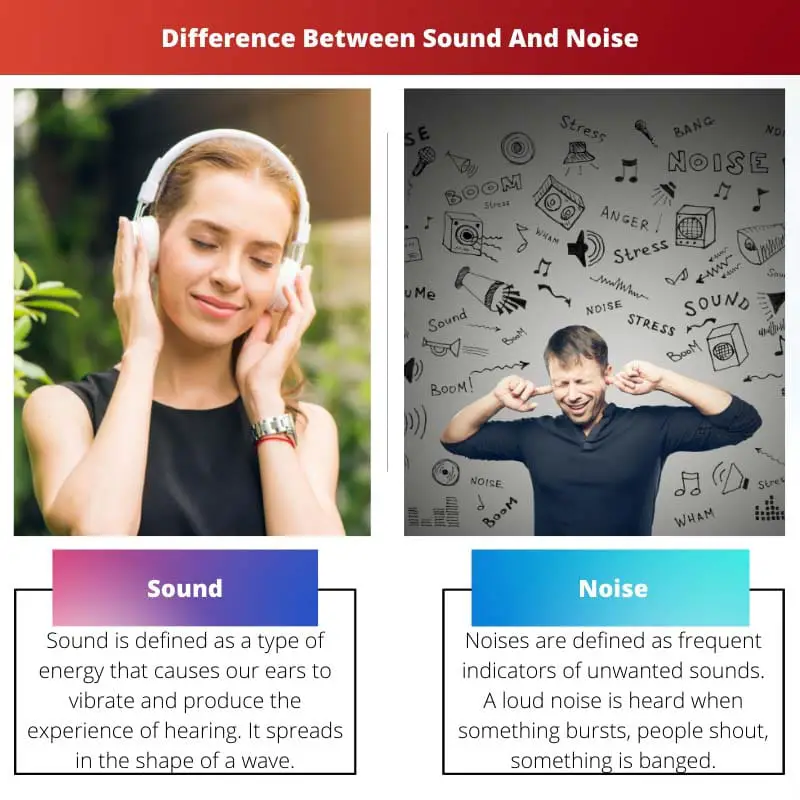Noise and sound are both vibrations across a medium, such as air or water, and are, therefore, identical in terms of physics. When the brain receives and interprets a sound, the difference arises. But often, these terms are used interchangeably.
The change from sound to noise is a societal decision that differs between cultures and individuals. It is a matter of personal opinion.
Key Takeaways
- Sound is an organized and structured vibration of air molecules perceived as pleasant or meaningful, while noise is disorganized and chaotic, considered unwanted or disturbing.
- Sound can convey information and elicit emotions, whereas noise interferes with communication and can cause stress or discomfort.
- Musical instruments and human speech produce sounds, while construction sites and heavy traffic generate noise.
Sound Vs Noise
Sound refers to any auditory sensation that is perceived by the human ear, whether it is pleasant or unpleasant, it can be music, speech, nature sounds, or any other type of acoustic signal. Noise, on the other hand, is defined as any undesired or unpleasant sound that interferes with or disturbs normal hearing, communication, or other activities.

A sound is a type of energy that produces audible sensations. In physics, sound is a vibration that travels through a transmission medium such as air or water as an audible mechanical wave of pressure and displacement.
Sound transmission is the apex of such waves and their perception by the brain in physiology and psychology.
Noises are frequently indicators of danger and elicit dread. Tones can indicate danger, but they can also indicate comfort and safety.
We learn what noises signify at a young age and continue to respond to them as we have for the rest of our lives. This is why noises have such a strong emotional impact on humans.
Comparison Table
| Parameters of Comparison | Sound | Noise |
|---|---|---|
| Definition | Sound is defined as a type of energy that causes our ears to vibrate and produce the experience of hearing. It spreads in the shape of a wave. | Noises are defined as frequent indicators of unwanted sounds. A loud noise is heard when something bursts, people shout, something is banged, or a large object falls. |
| Motion | Sound has regular periodic motion. | Noise has irregular periodic motion. |
| Pitch | The sound has a consistent pitch. | Noise has a changing or varying pitch. |
| Health effects | Sound doesn’t cause negative effects on health. | Noise causes negative effects on one’s health like hypertension etc. |
| Types | There are various types of sounds, some of them are soft, pleasant, unpleasant, audible, musical and loud, etc. | There are three types of noises and are Continuous noise, impulsive noise, and intermittent noise are the types. |
What is Sound?
Any pressure variation in air, water, or another fluid media that the human ear can recognize is characterized as sound.
The loudness and frequency of the sound are the two most significant properties to know while evaluating it.
The loudness or intensity is determined by the amplitude or height of the sound wave from peak to valley. The frequency, pitch, and tone of a sound are all determined by wavelength.
The speed of sound determines how fast sound waves move through the air. Natural observation demonstrates this; a lightning bolt is seen in the distance, and thunder is heard at a later time.
The speed of sound is affected by pressure, temperature, density, and their interactions.
Consider a sound wave traveling through a gas that isn’t moving. The sound wave is produced by a source, such as a firework exploding in the corner of a room.
The sound wave sweeps by you at a certain speed if you are standing in the center of the room. The sound wave is a thin zone of disturbance in the air that causes tiny changes in pressure, temperature, and density.
Your eardrum is activated by a change in pressure, which allows you to hear the sound.

What is Noise?
Noise is defined as an undesirable disturbance in a system that causes unexpected repercussions, decreased efficiency, or faulty measurement in the sciences.
Noise is a vibration that we can hear because it falls within our audible range. For things we can see, we have a spectrum of light.
Everything in life is nothing more than vibrations. Certain signals can pass through walls because it vibrates considerably lower than the physical wall object.
The sun is producing a massive ultrasonic right now, but it’s so loud that it’s beyond our range of hearing, therefore, it’s dubbed Ultra.
Doctors use “Ultra Noise” technology called ultrasounds to see newborns in their mothers’ tummies.
Many animals, including dolphins, can emit ultrasounds, or vibrations, with their tongues. Echolocations are what they’re called. A similar effect is used by Radars with sound.
Ultrasounds can be heard faintly by infants, but as the child grows older, the ultrasounds fade away.
Also, noise is any undesired sound that is unpleasant, loud, or distracting to the listener’s ability to hear.
Noise irritates or annoys people psychologically. In this category, we can include rap music and boom boxes.
It has been demonstrated to increase stress, impair concentration, and make people more irritable at certain levels.
It can cause physical harm to the ears if the concentration is high enough.

Main Differences Between Sound And Noise
- The brain’s interpretation of air vibrations is sound. In contrast, Noise is sound that the brain interprets as disorganized.
- The sound (or stimulus) that serves our aim is referred to as a signal. Noise, on the other hand, is sound (or stimuli) that does not serve our needs.
- Everything audible that one can perceive is referred to as sound. While everything that is classified as unpleasant and incomprehensible is referred to as noise.
- Periodic vibrations produce sound, whereas aperiodic, uneven vibrations produce noise.
- Sound is orderly, with rhythm, or simply pleasant, whereas noise is unpleasant, disordered, and undesirable.

- https://onlinelibrary.wiley.com/doi/abs/10.1111/0022-1082.00393
- https://journals.plos.org/plosone/article?id=10.1371/journal.pone.0017266
- https://ntrs.nasa.gov/api/citations/19690003260/downloads/19690003260.pdf

The article effectively distinguishes sound from noise with a scientific and physiological approach. The detailed analysis of sound waves and perception adds depth to the post, making it a valuable resource for understanding acoustic phenomena.
I find the societal aspects of distinguishing between sound and noise intriguing. The role of culture and individual perception is fascinating and could be explored further in terms of its impact on environmental policies.
The post raises an interesting point about the emotional impact of noise and how it influences human behavior. I wish there was a more in-depth discussion on this topic, as it seems to be a crucial aspect of the human experience.
This post could benefit from a more engaging tone. While the content is informative, it lacks a captivating narrative to sustain reader interest. Incorporating real-life examples or anecdotes might enhance the overall appeal of the article.
Very informative post! It is essential to understand the definitions and differences between sound and noise, and how they influence human emotions and health. The comparison table provides a clear analysis of the two concepts.
I agree, the article is insightful and provides a comprehensive understanding of sound and noise. The references are beneficial for further reading.
The scientific explanation of sound and noise is well articulated, providing a clear understanding of the physical properties and effects on health. However, I wonder if there are practical applications or technologies developed based on the knowledge presented.